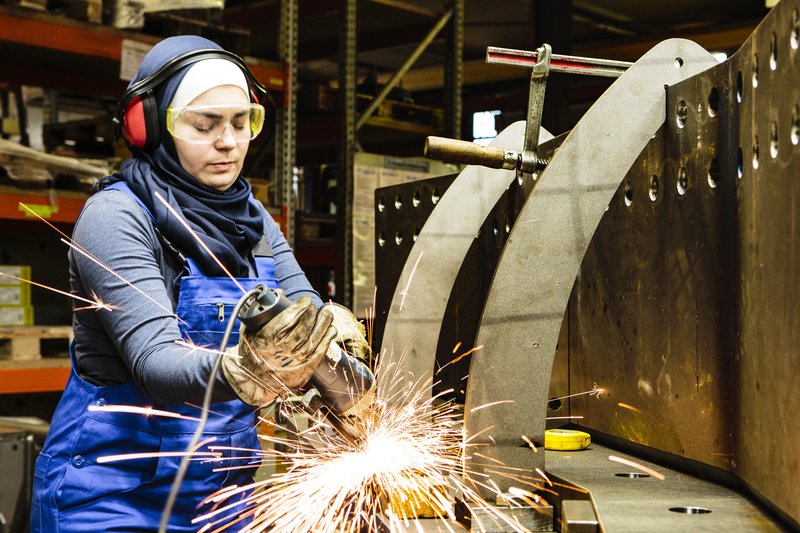

From Military Service to Civilian Employment
May 23, 2023
At a Glance
Veterans and employers leverage digital tools to connect the dots between military service experience and required industry credentials.
Of the nearly 200,000 servicemembers transitioning from military to civilian lives annually, only one in four have jobs lined up after leaving the armed forces. And even though a sizable chunk of these individuals enroll in further education upon leaving, nearly one-third of those who find a job are underemployed. Veterans are often expected to pursue entire certification or credentialing programs to demonstrate their readiness for civilian jobs if they did not attain them during their military service. Certainly, these troubling statistics would be much worse if not for the intervention of transition programs and community-based organizations to help coach and support veterans as they transition. But are redundant education requirements also delaying an already lengthy journey?
Many veteran job searches are hindered by a lack of resources for combating unemployment and the outdated notion that only four-year degrees translate to competency. Instead of looking at the whole picture, some employers ignore the very qualities that should create accessible and concrete on-ramps to quality civilian jobs, like the countless hours of specialized training and knowledge that servicemembers have in spades. Quality jobs are not easily accessible to these individuals—and the reality is, they should be.
As movements for skills-first practices continue to grow, we have an opportunity to create a better and more person-centered process that values what veterans bring to the table. By considering all their experiences, a skills-first approach will streamline servicemembers’ pathway to employment, not extend it by forcing inflexible, potentially unnecessary education and training into the process.
Building a Better System for Veterans
In the summer of 2022, Jobs for the Future, Solutions for Information Design, LLC (SOLID), and the Manufacturing Institute announced a partnership funded by Walmart to support the transition of U.S. military personnel into civilian employment in the modern manufacturing industry. The goal is two-fold: first, determine how to translate and map military occupational training and experience directly to industry skill certifications in manufacturing, and second, determine how to leverage digital credentials and platforms like the U.S. Department of Defense’s MilGears career planning tool, and the military Learner and Employment Record (LER) and digital wallets to help compare military experience against civilian credentials. These efforts will help qualify the valuable skills and knowledge gained during service and validate them as necessary for quality jobs in the manufacturing industry.
The manufacturing sector is the perfect starting point for us to understand how we can grow this transition process at scale, because the sector is primed for expansion following the Infrastructure Investment and Jobs Act. Further, roles in manufacturing are especially attractive because entry-level roles don’t require a return to school and present as quality job options for veterans, leading to economic mobility for themselves and their families.
Through the unique partnership across organizations in this project, SOLID identified a series of military occupations and evaluated key activities and training that are tied to those occupations. Then, with the help of subject matter experts, SOLID mapped these occupations directly to the critical work function modules developed by the Manufacturing Skills Standards Council, and elevated key skills. Finally, these aligned skills have been translated into a series of digital credentials that are supported by the Manufacturing Institute. Individuals may earn certain clusters of these credentials, and upon completion, will be able to easily identify knowledge gaps (if any) should they choose to pursue careers in manufacturing.
Our next steps include meeting with transitioning service members, veterans, and manufacturing employers to assess if the credentials matter and whether they actually help identify quality candidates in a talent pool. Through community-based transition programs like Hire Heroes USA, we will also work directly with transitioning service members and veterans to understand if these credentials help them identify more specific training to fill gaps, rather than pursuing entire certifications in manufacturing—and we will check in with transition programs to explore how this helps them build more tailor-made training programs that allow for more personalized learning opportunities.

Easing Access to Careers in Manufacturing for Veterans
Together, digital credentialing technologies, career planning tools like MilGears and the record it produces, and a commitment to skills-first practices can transform how service members leverage their experiences for civilian careers and continuing education. But this requires buy-in from all stakeholders, including community-based organizations, education providers, and employers.
There’s still work to be done, but we hope our efforts result in a streamlined process for individuals as they transition out of military service: not only to understand how their experience sets them up to access jobs in manufacturing but also to establish a tool to effectively communicate to employers what these veterans offer as a candidate pursuing a job. Moreover, community-based organizations and transition services can rely on these tools to help tailor their coaching and create modular training that allows veterans to fill in the knowledge gaps rather than dutifully pursuing entire certification courses, no questions asked.
As we move from prototyping this process to field testing it, we anticipate developing best practices that can scale across industries for how to develop skills-driven credentialing across all military occupations in addition to extending beyond the manufacturing sector.
Over time, this effort will increase the number of veterans moving into quality jobs more quickly, with less time lost to education that is not helpful for advancement. It will also enable employers to identify qualified and reliable talent more efficiently by using streamlined, technology-driven transition support services.
Related Content


Digital Learning Records Make the Job Market More Equitable and CBOs Can Help
Community based organizations have an important role to play in a large-scale effort to build systems that increase access to good jobs by enabling workers to share digital records of their education and employment histories…
